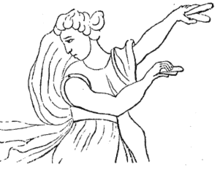Crotalum
In classical antiquity, a crotalum (Ancient Greek: κρόταλον krotalon)[2] was a kind of clapper or castanet used in religious dances by groups in ancient Greece and elsewhere, including the Korybantes.[3][4]
The term has been erroneously supposed by some writers to be the same as the sistrum. These mistakes are refuted at length by Friedrich Adolph Lampe (1683-1729) in De cymbalis veterum.[5] From the Suda and the Scholiast on Aristophanes (Nubes, 260), it appears to have been a split reed or cane, which clattered when shaken with the hand. According to Eustathius (Il. XI.160), it was made of shell and brass, as well as wood. Clement of Alexandria attributes the instruments invention to the Sicilians, and forbids the use thereof to the Christians, because of the motions and gestures accompanying the practice.[6][7]
Women who played on the crotalum were termed crotalistriae. Such was Virgil's Copa (2),
- "Crispum sub crotalo docta movere latus."
This line alludes to the dance with crotala (similar to castanets), for which we have the additional testimony of Macrobius (Saturnalia III.14.4‑8).[6]
As the instrument made a noise somewhat like that of a crane's bill, the bird was called crotalistria, "player on crotala".[7]
Pausanias affirms by way of the epic poet Pisander of Camirus that Heracles did not kill the birds of Lake Stymphalia, but that he drove them away by playing on crotala. Based on this, the instrument must be exceedingly ancient.[7][8][9]
The word krotalon is often applied, by an easy metaphor, to a noisy talkative person (Aristoph. Nub. 448; Eurip. Cycl. 104).[6] One of the Spanish names for "rattlesnake" is crótalo.[10]
References
- sec. i art. vi fig. 43
- κρόταλον. Liddell, Henry George; Scott, Robert; A Greek–English Lexicon at the Perseus Project.
-
 This article incorporates text from a publication now in the public domain: Porter, Noah, ed. (1913). Webster's Dictionary. Springfield, Massachusetts: C. & G. Merriam Co. Missing or empty
This article incorporates text from a publication now in the public domain: Porter, Noah, ed. (1913). Webster's Dictionary. Springfield, Massachusetts: C. & G. Merriam Co. Missing or empty |title=(help) - "crotalum". Oxford English Dictionary (Online ed.). Oxford University Press. (Subscription or participating institution membership required.)
- i.4, 5, 6
-
 This article incorporates text from a publication now in the public domain: Smith, William, ed. (1870). Dictionary of Greek and Roman Antiquities. London: John Murray. Missing or empty
This article incorporates text from a publication now in the public domain: Smith, William, ed. (1870). Dictionary of Greek and Roman Antiquities. London: John Murray. Missing or empty |title=(help) -
 This article incorporates text from a publication now in the public domain: Chambers, Ephraim, ed. (1728). Cyclopædia, or an Universal Dictionary of Arts and Sciences (1st ed.). James and John Knapton, et al. Missing or empty
This article incorporates text from a publication now in the public domain: Chambers, Ephraim, ed. (1728). Cyclopædia, or an Universal Dictionary of Arts and Sciences (1st ed.). James and John Knapton, et al. Missing or empty |title=(help) - Pausan. Arcad. lib. viii
- Wilkinson, John Gardner (1878). The Manners and Customs of the Ancient Egyptians. Vol 1. London: John Murray. p. 494.
- Diccionario de la lengua española.
